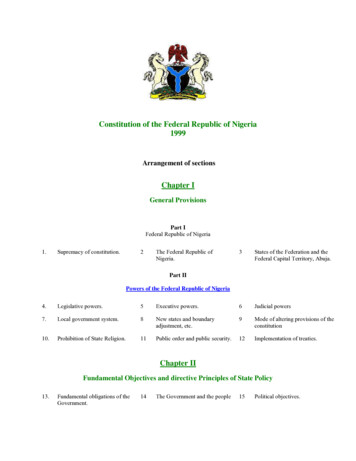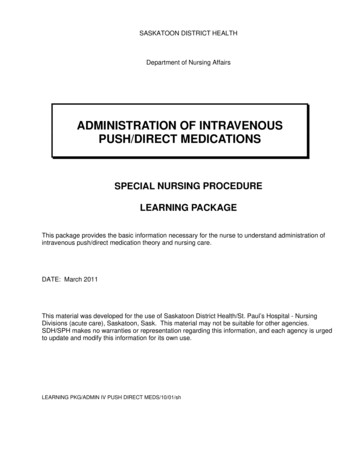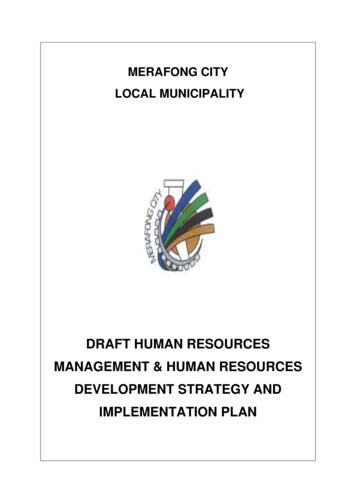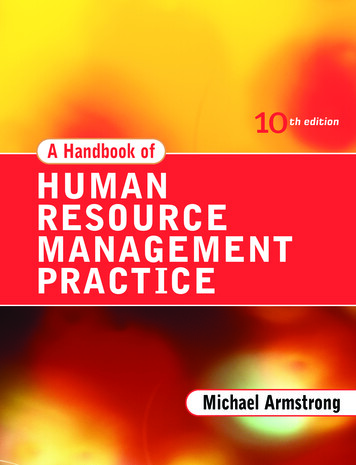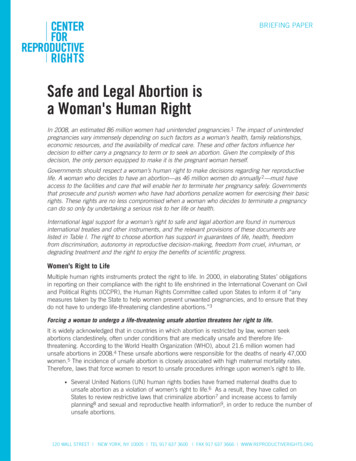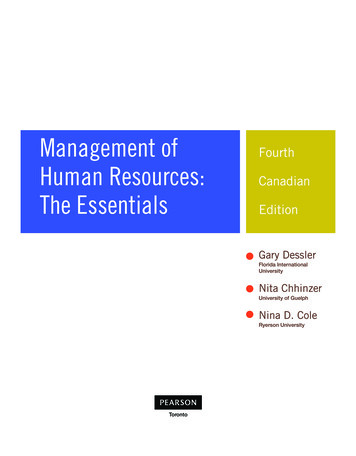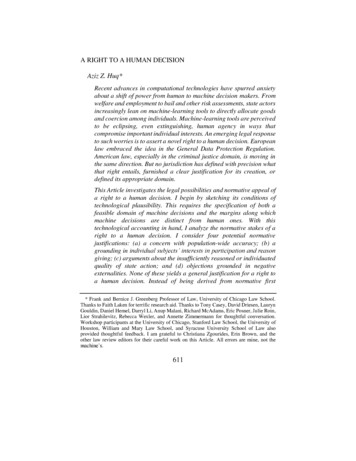
Transcription
A RIGHT TO A HUMAN DECISIONAziz Z. Huq*Recent advances in computational technologies have spurred anxietyabout a shift of powerfrom human to machine decision makers. Fromwelfare and employment to bail and other risk assessments, state actorsincreasinglylean on machine-learningtools to directly allocate goodsand coercion among individuals. Machine-learning tools are perceivedto be eclipsing, even extinguishing, human agency in ways thatcompromise important individual interests. An emerging legal responseto such worries is to assert a novel right to a human decision. Europeanlaw embraced the idea in the General Data Protection Regulation.American law, especially in the criminal justice domain, is moving inthe same direction. But no jurisdiction has defined with precision whatthat right entails, furnished a clear justificationfor its creation, ordefined its appropriatedomain.This Article investigates the legalpossibilities and normative appeal ofa right to a human decision. I begin by sketching its conditions oftechnological plausibility. This requires the specification of both afeasible domain of machine decisions and the margins along whichmachine decisions are distinct from human ones. With thistechnological accounting in hand, I analyze the normative stakes of aright to a human decision. I consider four potential normativejustifications: (a) a concern with population-wide accuracy; (b) agrounding in individual subjects' interests in participationand reasongiving; (c) arguments about the insufficiently reasonedor individuatedquality of state action; and (d) objections grounded in negativeexternalities. None of these yields a generaljustificationfor a right toa human decision. Instead of being derived from normative first* Frank and Bernice J. Greenberg Professor of Law, University of Chicago Law School.Thanks to Faith Laken for terrific research aid. Thanks to Tony Casey, David Driesen, LaurynGouldin, Daniel Hemel, Darryl Li, Anup Malani, Richard McAdams, Eric Posner, Julie Roin,Lior Strahilevitz, Rebecca Wexler, and Annette Zimmermann for thoughtful conversation.Workshop participants at the University of Chicago, Stanford Law School, the University ofHouston, William and Mary Law School, and Syracuse University School of Law alsoprovided thoughtful feedback. I am grateful to Christiana Zgourides, Erin Brown, and theother law review editors for their careful work on this Article. All errors are mine, not themachine's.611
Virginia Law Review612[Vol. 106:611principles, limits to machine decision making are appropriatelyfoundin the technical constraints on predictive instruments. Within thatdomain, concerns about due process, privacy, and discrimination inmachine decisions are typically best addressed through a justiciable"right to a well-calibratedmachine decision."613620INTRODUCTION.I.LEGAL ARTICULATIONS OF A RIGHT TO A HUMAN DECISION.A. The EuropeanRight to a Human Decision. 6211. Antecedents . 6212. Article 22 of the GDPR . 622B. American Law and the Right to a Human Decision. 624C. The Tentative Form of a Novel Right. 628II.THE DIFFERENCE BETWEEN MACHINE DECISIONS AND HUMAN629DECISIONS .A. Machine Learning as a SubstituteforHuman Decisions . 630B. The PlausibleDomain of Machine Decisions bythe State . 634C. DistinguishingMachinefrom Human Decisions. 6361. How Machine and Human Decisions Diverge inOperation. 6372. The Opacity of Other (Human and Machine)Minds . 640D. Entanglements of Human and Machine Action . 646III. CAN A RIGHT TO A HUMAN DECISION BE JUSTIFIED? .A. Accuracy in DecisionMaking .B. Subject-Facing Grounds.1. ParticipationInterests .2. Reason Giving .C. Classifier-FacingGrounds.1. Reasoned State Action.6516536566566616726732. The Right to an IndividualizedDecision. 675D. Systemic Concerns and Negative Externalities. 680E. PracticalConstraintson Machine Decisions . 685CONCLUSION:A RIGHTTO A WELL-CALIBRATED MACHINEDECISION? .686
2020]613A Right to a Human DecisionINTRODUCTIONEvery tectonic technological change-from the first graindomesticated to the first smartphone set abuzz'-begets a new society.Among the ensuing birth pangs are novel anxieties about how power isdistributed-how it is to be gained, and how it will be lost. A spate ofsudden advances in the computational technology known as machinelearning has stimulated the most recent rush of inky public anxiety. Thesenew technologies apply complex algorithms, 2 called machine-learninginstruments, to vast pools of public and government data so as to executetasks previously beyond mere human ability. 3 Corporate and state actorsincreasingly lean on these tools to make "decisions that affect people'slivesandlivelihoods-fromloansentencing, and college admissions."approvals,to recruiting,legal4As a result, many people feel a loss of control over key life decisions.5Machines, they fear, resolve questions of critical importance on grounds1 For recent treatments of these technological causes of social transformations, see generallyJames C. Scott, Against the Grain: A Deep History of the Earliest States (2017), and RaviAgrawal, India Connected: How the Smartphone is Transforming the World's LargestDemocracy (2018).2 Analgorithm is simply a "well-defined set of steps for accomplishing a certain goal."Joshua A. Kroll et al., Accountable Algorithms, 165 U. Pa. L. Rev. 633, 640 n.14 (2017); seealso Thomas H. Cormen et al., Introduction to Algorithms 5 (3d ed. 2009) (defining analgorithm as "any well-defined computational procedure that takes some value, or set ofvalues, as input and produces some value, or set of values, as output" (emphasis omitted)).The task of computing, at its atomic level, comprises the execution of serial algorithms. MartinErwig, Once Upon an Algorithm: How Stories Explain Computing 1-4 (2017).3 Machine learning is a general purpose technology that, in broad terms, encompasses"algorithms and systems that improve their knowledge or performance with experience." PeterFlach, Machine Learning: The Art and Science of Algorithms that Make Sense of Data 3(2012); see also Ethem Alpaydin, Introduction to Machine Learning 2-3 (3d ed. 2014)(defining machine learning in similar terms). For the uses of machine learning, see SusanAthey, Beyond Prediction: Using Big Data for Policy Problems, 355 Science 483, 483 (2017)(noting the use of machine learning to solve prediction problems). I discuss the technologicalscope of the project, and define relevant terms, infra at text accompanying note 111. I will usethe terms "algorithmic tools" and "machine learning" interchangeably, even though the classof algorithms is technically much larger.a Kartik Hosanagar & Vivian Jair, We Need Transparency in Algorithms, But Too MuchCan Backfire, Harv. Bus. Rev. (July 23, 2018), /7KQ9-QMF3];accord CaryCoglianese & David Lehr, Regulating by Robot: Administrative Decision Making in theMachine-Learning Era, 105 Geo. L.J. 1147, 1149 (2017).s Shoshana Zuboff, Big Other: Surveillance Capitalism and the Prospects of an InformationCivilization, 30 J. Info. Tech. 75, 75 (2015) (describing a "new form of information capitalism
614Virginia Law Review[Vol. 106:611that are beyond individuals' ken or control. 6 Many individuals experiencea loss of elementary human agency and a corresponding vulnerability toan inhuman and inhumane machine logic. For some, "the very idea of analgorithmic system making an important decision on the basis of past dataseem[s] unfair."7 Machines, it is said, want fatally for "empathy." 8 Forothers, machine decisions seem dangerously inscrutable, non-transparent,and so hazardously unpredictable. 9 Worse, governments and companieswield these tools freely to taxonomize their populations, predictindividual behavior, and even manipulate behavior and preferences inways that give them a new advantage over the human subjects ofalgorithmic classification.10 Even the basic terms of political choice seemcompromised." At the same time that machine learning is poised torecalibrate the ordinary forms of interaction between citizen andgovernment (or big tech), advances in robotics as well as machinelearning appear to be about to displace huge tranches of both blue-collarand white-collar labor markets.1 2 A fearful future looms, one[that] aims to predict and modify human behavior as a means to produce revenue and marketcontrol").6 See, e.g., Rachel Courtland, The Bias Detectives, 558 Nature 357, 357 (2018)(documenting concerns among the public that algorithmic risk scores for detecting child abusefail to account for an "effort . . to turn [a] life around").Reuben Binns et al., 'It's Reducing a Human Being to a Percentage'; Perceptions of Justicein Algorithmic Decisions, 2018 CHI Conf. on Hum. Factors Computing Systems 9 (emphasisomitted).8 Virginia Eubanks, Automating Inequality: How High-Tech Tools Profile, Police, andPunish the Poor 168 (2017).9 Will Knight, The Dark Secret at the Heart of Al, MIT Tech. Rev. (Apr. 11, /L94L-LYTJ] ("The computers that run those services have programmedthemselves, and they have done it in ways we cannot understand. Even the engineers whobuild these apps cannot fully explain their behavior.").10 For consideration of these issues, see Mariano-Florentino Cu6llar & Aziz Z. Huq,Economies of Surveillance, 133 Harv. L. Rev. 1280 (2020), and Mariano-Florentino Cu6llar& Aziz Z. Huq, Privacy's Political Economy and the State of Machine Learning: An Essay inHonor of Stephen J. Schulhofer, N.Y.U. Ann. Surv. Am. L. (forthcoming 2020)." See, e.g., Daniel Kreiss & Shannon C. McGregor, Technology Firms Shape PoliticalCommunication: The Work of Microsoft, Facebook, Twitter, and Google with CampaignsDuring the 2016 U.S. Presidential Cycle, 35 Pol. Comm. 155, 156-57 (2018) (describing therole of technology firms in shaping campaigns).12 For what has become the standard view, see Larry Elliott, Robots Will Take Our Jobs.We'd Better Plan Now, Before It's Too Late, Guardian (Feb. 1, 2018, 1:00 /feb/0l/robots-take-our-jobs-amazon-goseattle [https://perma.cc/2CFP-3JJV]. For a more nuanced account, see Martin Ford, Rise ofthe Robots: Technology and the Threat of a Jobless Future 282-83 (2015).
2020]A Right to a Human Decision615characterized by massive economic dislocation, wherein people have lostcontrol of many central life choices, and basic consumer and politicalpreferences are no longer really one's own.This Article is about one nascent and still inchoate legal response tothese fears: the possibility that an individual being assigned a benefit or acoercive intervention has a right to a human decision rather than adecision reached by a purely automated process (a "machine decision").European law has embraced the idea. American law, especially in thecriminal justice domain, is flirting with it. 13 My aim in this Article is totest this burgeoning proposal, to investigate its relationship withtechnological possibilities, and to ascertain whether it is a cogent responseto growing distributional, political, and epistemic anxieties. My focus isnot on the form of such a right-statutory, constitutional, or treatybased-or how it is implemented-say, in terms of liability or propertyrule protection-but more simply on what might ab initio justify itscreation.To motivate this inquiry, consider some of the anxieties unfurlingalready in public debate: A nursing union, for instance, launched acampaign urging patients to demand human medical judgments ratherthan technological assessment. 14 And a majority of patients surveyed in a2018 Accenture survey preferred treatment by a doctor in person to virtualcare.15 When California proposed replacing money bail with a "risk-basedpretrial assessment" tool, a state court judge warned that "[t]echnologycannot replace the depth of judicial knowledge, experience, and expertisein law enforcement that prosecutors and defendants' attorneys possess."16In 2018, the City of Flint, Michigan, discontinued the use of a highlyeffective machine-learning tool designed to identify defective waterpipes, reverting under community pressure to human decision making13See infra text accompanying notes 70-73.'When It Matters Most, Insist on a Registered Nurse,' Nat'l Nurses United, ered-nurse [https://perma.cc/MB66-XTXW] (last visitedJan. 19, 2020)." Accenture Consulting, 2018 Consumer Survey on Digital Health: US Results 9 (2018),https://www.accenture.com/ veyDigital-Health.pdf#zoom 50 [https://perma.cc/TU5F-9J82].16 Quentin L. Kopp, Replacing Judges with Computers Is Risky, Harv. L. Rev. Blog(Feb. 20, 2018), VF]. On the current state of affairs, see California Set to GreatlyExpand Controversial Pretrial Risk Assessments, Filter (Aug. 7, 2019), -expand-controversial-pretrial-risk-assessments/ [https://perma.cc/2FNX-U3C9].1
616Virginia Law Review[Vol. 106:611with a far lower hit rate for detecting defective pipes." Finally, andperhaps most powerfully, consider the worry congealed in an anecdotetold by data scientist Cathy O'Neil: An Arkansas woman namedCatherine Taylor is denied federal housing assistance because she fails anautomated, "webcrawling[,] data-gathering" background check.18 It isonly when "one conscientious human being" takes the trouble to look intothe quality of this machine result that it is discovered that Taylor has beenred-flagged in error.19 O'Neil's plainly troubling anecdote powerfullycaptures the fear that machines will be unfair, incomprehensive, orincompatible with the flexing of elementary human agency: it provides asharp spur to the inquiry that follows.The most important formulation of a right to a human decision to dateis found in European law. In April 2016, the European Parliament enacteda new regime of data protection in the form of a General Data ProtectionRegulation (GDPR). 20 Unlike the legal regime it superseded, 21 the GDPRas implemented in May 2018 is legally mandatory even in the absence ofimplementing legislation by member states of the European Union(EU). 22 Hence, it can be directly enforced in court through hefty financialpenalties. 23 Article 22 of the GDPR endows a natural individual with "theright not to be subject to a decision based solely on automated processing,including profiling, which produces legal effects concerning him or heror similarly significantly affects him or her." 24 That right covers private" Alexis C. Madrigal, How a Feel-Good Al Story Went Wrong in Flint, Atlantic (Jan. 3,2019), 578692/ [https://perma.cc/V8VA-F22W]."Cathy O'Neil, Weapons of Math Destmction: How Big Data Increases Inequality andThreatens Democracy 152-53 (2016).19 Id. at 153.20 Regulation 2016/679, of the European Parliament and of the Council of 27 April 2016 onthe Protection of Natural Persons with Regard to the Processing of Personal Data and on theFree Movement of Such Data, and Repealing Directive 95/46/EC (General Data ProtectionRegulation), 2016 O.J. (L 119) (EU) [hereinafter GDPR]; see also Christina Tikkinen-Piri,Anna Rohunen & Jouni Markkula, EU General Data Protection Regulation: Changes andImplications for Personal Data Collecting Companies, 34 Computer L. & Security Rev. 134,134-35 (2018) (documenting the enactment process of the GDPR).21 See Directive 95/46, of the European Parliament and of the Council of 24 October 1995on the Protection of Individuals with Regard to the Processing of Personal Data and on theFree Movement of Such Data, art. 1, 1995 O.J. (L 281) (EC) [hereinafter Directive 95/46].22 Bryce Goodman & Seth Flaxman, European Union Regulations on Algorithmic DecisionMaking and a "Right to Explanation," Al Mag., Fall 2017, at 51-52 (explaining the differencebetween a non-binding directive and a legally binding regulation under European law).23 Id. at 52.2 GDPR, supra note 20, arts. 4(1), 22(1) (inter alia, defining "data subject").
2020]A Right to a Human Decision617and some (but not all) state entities. 2 On its face, it fashions an opt-out ofquite general scope from automated decision making. 26The GDPR also has extraterritorial effect. 27 It reaches platforms, suchas Google and Facebook, that offer services within the EU. 28 AndAmerican law is also making tentative moves toward a similar right to ahuman decision. In 2016, for example, the Wisconsin Supreme Court heldthat an algorithmically generated risk score "may not be considered as thedeterminative factor in deciding whether the offender can be supervisedsafely and effectively in the community" as a matter of due process. 29That decision precludes full automation of bail determinations. Theremust be a human judge in the loop. The Wisconsin court's holding isunlikely to prove unique. State deployment of machine learning has, moregenerally, elicited sharp complaints sounding in procedural justice andfairness terms. 30 Further, the Sixth Amendment's right to a jury trial hasto date principally been deployed to resist judicialfactfinding. 3 1 But thereis no conceptual reason why the Sixth Amendment could not be invokedto preclude at least some forms of algorithmically generated inputs tocriminal sentencing. Indeed, it would seem to follow a fortiori that a rightprecluding a jury's substitution with a judge would also block itsdisplacement by a mere machine.25See id. art. 4(7)-(8) (defining "controller" and "processor" as key scope terms). TheRegulation, however, does not apply to criminal and security investigations. Id. art. 2(2)(d).26 As I explain below, this is not the only provision of the GDPR that can be interpreted tocreate a right to a human decision. See infra text accompanying notes 53-58.27 GDPR, supra note 20, art. 3.28There is sharp divergence in the scholarship over the GDPR's extraterritorial scope, whichranges from the measured, see Griffin Drake, Note, Navigating the Atlantic: UnderstandingEU Data Privacy Compliance Amidst a Sea of Uncertainty, 91 S. Cal. L. Rev. 163, 166 (2017)(documenting new legal risks to American companies pursuant to the GDPR), to the alarmist,see Mira Burri, The Governance of Data and Data Flows in Trade Agreements: The Pitfalls ofLegal Adaptation, 51 U.C. Davis L. Rev. 65, 92 (2017) ("The GDPR is, in many senses,excessively burdensome and with sizeable extraterritorial effects.").29 State v. Loomis, 881 N.W.2d 749, 760 (Wis. 2016).30 See, e.g., Julia Angwin, Jeff Larson, Surya Mattu & Lauren Kirchner, Machine Bias:There's Software Used Across the Country to Predict Future Criminals. And It's BiasedAgainst Blacks, ProPublica 2 (May 23, 2016), .cc/Q9ZU-VY6J](criticizingmachine-learning instruments in the criminal justice context).31 See, e.g., Apprendi v. New Jersey, 530 U.S. 466, 477 (2000) (explaining that the Fifthand Sixth Amendments "indisputably entitle a criminal defendant to a jury determination that[he] is guilty of every element of the crime with which he is charged, beyond a reasonabledoubt" (alteration in original) (internal quotation marks omitted) (quoting United States v.Gaudin, 515 U.S. 506, 510 (1995))).
618Virginia Law Review[Vol. 106:611In this Article, I start by situating a right to a human decision in itscontemporary technological milieu. I can thereby specify the feasibledomain of machine decisions. I suggest this comprises decisions taken athigh volume in which sufficient historical data exists to generate effectivepredictions. Importantly, this excludes many matters presently resolvedthrough civil or criminal trials but sweeps in welfare determinations,hiring decisions, and predictive judgments in the criminal justice contextsof bail and sentencing. Second, I examine the margins along whichmachine decisions are distinct from human ones. My focus is on a groupof related technologies known as machine learning. This is the form ofartificial intelligence diffusing most rapidly today. 3 2 A right to a humandecision cannot be defined or evaluated without some sense of thetechnical differences between human decision making and decisionsreached by these machine-learning technologies. Indeed, careful analysisof how machine learning is designed and implemented reveals that thedistinctions between human and machine decisions are less crisp thanmight first appear. Claims about a right to human decision, I suggest, arebetter understood to turn on the timing, and not the sheer fact, of suchinvolvement.With this technical foundation in hand, I evaluate the right to a humandecision in relation to four normative ends it might plausibly beunderstood to further. A first possibility turns on overall accuracy worries.My second line of analysis takes up the interests of an individual exposedto a machine decision. The most pertinent of these interests hinge uponan individual's participation in decision making and her opportunity tooffer reasons. A third analytic salient tracks ways that a machineinstrument might be intrinsically objectionable because it uses a deficientdecisional protocol. I focus here on worries about the absence ofindividualized consideration and a machine's failure to offer reasoned32 See infra text accompanying note 88 (defining machine learning). I am not alone in thisfocus. Legal scholars are paying increasing attention to new algorithmic technologies. Forleading examples, see Kate Crawford & Jason Schultz, Big Data and Due Process: Toward aFramework to Redress Predictive Privacy Harms, 55 B.C. L. Rev. 93, 109 (2014) (arguing for"procedural data due process [to] regulate the fairness of Big Data's analytical processes withregard to how they use personal data (or metadata . )"); Andrew Guthrie Ferguson, Big Dataand Predictive Reasonable Suspicion, 163 U. Pa. L. Rev. 327, 383-84 (2015) (discussing thepossible use of algorithmic prediction in determining "reasonable suspicion" in criminal law);Kroll et al., supra note 2, at 636-37; Michael L. Rich, Machine Learning, AutomatedSuspicion Algorithms, and the Fourth Amendment, 164 U. Pa. L. Rev. 871, 929 (2016)(developing a "framework" for integrating machine-learning technologies into FourthAmendment analysis).
2020]A Right to a Human Decision619judgments. Finally, I consider dynamic, system-level effects (i.e.,negative spillovers), in particular in relation to social power. None ofthese arguments ultimately provides sure ground for a legal right to ahuman decision.Rather, I suggest that the limits of machine decision making be plottedbased on its technical constraints. Machines should not be used whenthere is no tractable parameter amenable to prediction. For example, ifthere is no good parameter that tracks job performance, then machineevaluation of those employees should be abandoned. Nor should they beused when decision making entails ethical or otherwise morally chargedjudgments. Most important, I suggest that machine decisions should besubject to a right to a well-calibratedmachine decision that folds in dueprocess, privacy, and equality values. 33 This is a better response than aright to a human decision to the many instruments now implemented bythe government that are highly flawed. 34My analysis here focuses on state action that imposes benefits orcoercion on individuals-and not on either private action or a broaderarray of state action-for three reasons. First, salient U.S. legalframeworks, unlike the GDPR's coverage, are largely (although notexclusively) trained on state action. Accordingly, a focus on state actionmakes sense in terms of explaining and evaluating the current U.S.regulatory landscape. Second, the range of private uses of algorithmictools is vast and heterogenous. Algorithms are now deployed in privateactivities ranging from Google's PageRank instrument, 35 to "fintech"applied to generate new revenue streams, 36 to medical instruments usedto calculate stroke risk,37 to engineers' identification of new stable33A forthcoming companion piece develops a more detailed account of how this right wouldbe vindicated in practice through a mix of litigation and regulation. See Aziz Z. Huq,Constitutional Rights in the Machine Learning State, 105 Cornell L. Rev. (forthcoming 2020).34 For a catalog, see Meredith Whittaker et al., Al Now Inst., Al Now Report 2018, at 1822 (2018), https://ainowinstitute.org/AINow 2018 Report.pdf [https://perma.cc/2BCG-M454].35 See, e.g., David Segal, The Dirty Little Secrets of Search: Why One Retailer Kept PoppingUp as No. 1, N.Y. Times, Feb. 13, 2011, at BU1.36 See Falguni Desai, The Age of Artificial Intelligence in Fintech, Forbes (June 30, 2016,10:42 PM), 0/the-age-of-artificial-intelligence-in-fintech [https://perma.cc/DG8N-8NVS] (describing how fintech firms use artificialintelligence to improve investment strategies and analyze consumer financial activity).37 See, e.g., Benjamin Letham, Cynthia Rudin, Tyler H. McCormick & David Madigan,Interpretable Classifiers Using Rules and Bayesian Analysis: Building a Better StrokePrediction Model, 9 Annals Applied Stat. 1350, 1350 (2015).
Virginia Law Review620[Vol. 106:611inorganic compounds. 3 8 Algorithmic tools are also embedded within newapplications, such as voice recognition software, translation software, andvisual recognition systems. 39 In contrast, the state is to date anunimaginative user of machine learning, with a relatively constraineddomain of deployments.4 0 This makes for a more straightforward analysis.Third, where the state does use algorithmic tools, it often results directlyor indirectly in deprivations of liberty, freedom of movement, bodilyintegrity, or basic income. These normatively freighted machine decisionspresent arguably the most compelling circumstances for adopting a rightto a human decision and so are a useful focus of normative inquiry.The Article proceeds in three steps. Part I catalogs ways in which lawhas crafted, or could craft, a right to a human decision. This taxonomicalenterprise demonstrates that such a right is far from fanciful. Part IIdefines the class of computational tools to be considered, explores themanner in which such instruments can be used, and teases out how theyare (or are not) distinct from human decisions. Doing so helps illuminatethe plausible forms of a right to a human decision. Part III then turns tothe potential normative foundations of such a right. It provides a carefultaxonomy of those grounds. It then shows why they all fall short. Finally,a brief conclusion inverts the Article's analytic lens to gesture at thepossibility that a right to a well-calibrated machine decision can beimagined, and even defended, on more persuasive terms than a right to ahuman decision.I.LEGAL ARTICULATIONS OF A RIGHT TO A HUMAN DECISIONThis Part documents ways in which law creates something like a rightto a human decision. I use the term "law" here capaciously to extendbeyond U.S. jurisprudence to European directives, and to range acrossboth private and public law domains capturing the regulation of state andnonstate action. I take this wide-angle view in this Part so as to developan understanding of several aspects of this putative right: the reasons forwhich it is articulated; the contexts in which it is applied; and the limitswith which it is hedged. That inquiry is largely descriptive. By surveyingthe current legal landscape, I offer a proof of concept to the effect that a38 See, e.g., Paul Raccuglia et al., Machine-Learning-Assisted Materials Discovery UsingFailed Experiments, 533 Nature 73, 73 (2016) (identifying new vanadium compounds).39 Yann LeCun et al., Deep Learning, 521 Nature 436, 438-41 (2015).40 See infra text accompanying notes 117-21 (describing state uses of machine learning).
A Right to a Human Decision2020]621right to a human decision is not so outlandish a notion as to be dismissedout of hand. At the same time, the opacities and limits of current lawprovide evidence of the difficulties packed into any effort to vest such aright in individuals.A. The European Right to a Human DecisionEuropean law has, in some form, recognized something akin to a rightto a human decision since 1978. Although that right has to date not hadmuch practical legal impact, the GDPR's enactment may generate aconcrete effect. Historical antecedents to Article 22 of the GDPR also castsome light on the difficulties of fashioning such a right and discerning itsjustifications.1. AntecedentsAn early antecedent of a right to a human decision i
(2012); see also Ethem Alpaydin, Introduction to Machine Learning 2-3 (3d ed. 2014) (defining machine learning in similar terms). For the uses of machine learning, see Susan Athey, Beyond Prediction: Using Big Data for Policy Problems, 355 Science 483, 483 (2017) (noting the use of machine learning to solve prediction problems).


